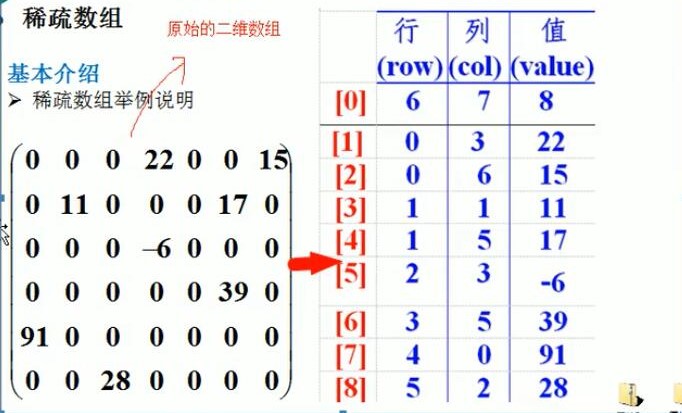1. 数据结构
1.1 线性结构
(1)最常用的数据结构,特点是数据元素之间存在一对一的线性关系
(2)有两种不同的存储结构,即顺序存储结构和链式存储结构
-顺序存储的线性表称为顺序表,顺序表中的存储元素是连续的
-链式存储的线性表称为链表,链表中的存储元素不一定是连续的,元素节点中存放数据元素以及相邻元素的地址信息
(3)常见的有:数组、队列、链表和栈
1.2 非线性结构
包括:二维数组,多维数组,广义表,树结构,图结构
2.稀疏数组和队列
2.1 稀疏sparsearray数组
(1)实际需求:编写五子棋程序,有存盘退出和续上盘的功能

-问题分析:因为该二维数组的很多值是默认值0,因此记录了很多没有意义的数据--->稀疏数组
(2)基本介绍
-当一个数组中的大部分元素为0,或者为同一个值的数组时,可以使用稀疏数组来保存该数组。
-稀疏数组的处理方法:
--记录数组一共有几行几列,有多少个不同的值
--把具有不同值的行列及值记录在一个小规模的数组中,从而缩小程序的规模

2.2 应用实例分析
(1)二维数组转稀疏数组的思路
-遍历原始二维数组,得到有效数据的个数sum
-根据sum创建稀疏数组sparseArr int[sum+1][3]
-将二维数组的有效数据存入到稀疏数组
(2)稀疏数组转原始的二维数组的思路
-读取稀疏数组第一行,根据第一行数据创建原始二维数组,如chessArr=int[11][11]
-读取稀疏数组后几行的数组,赋值给原始的二维数组
(3)代码实现
public static void main(String[] args)throws Exception { // TODO Auto-generated method stub //创建一个原始的二维数组11*11 //0:表示没有棋子,1表示黑子,2表示蓝子 int chessArr1[][]=new int[11][11]; chessArr1[1][2]=1; chessArr1[2][4]=2; //输出原始的二维数组 System.out.println("原始的二维数组:"); for(int[] row:chessArr1){ for(int data:row) { System.out.printf("%d ",data); } System.out.println(); } //将二维数组转稀疏数组的思想 //1.先遍历二维数组得到非0数据的个数 int sum=0; for(int i=0;i<11;i++){ for(int j=0;j<11;j++){ if(chessArr1[i][j]!=0){ sum++; } } } System.out.println(sum); //2.创建对应的稀疏数组 int sparseArr[][]=new int[sum+1][3]; //给稀疏数组赋值 sparseArr[0][0]=11; sparseArr[0][1]=11; sparseArr[0][2]=sum; //创建map.data文件 File map1=new File("map.data"); FileWriter fw=new FileWriter(map1); fw.write(11+" "); fw.write(11+" "); fw.write(sum+" "); //遍历二维数组,存放到稀疏数组中 int count=0;//count 用于记录是第几个非0书 for(int i=0;i<11;i++){ for(int j=0;j<11;j++){ if(chessArr1[i][j]!=0){ count++; sparseArr[count][0]=i; sparseArr[count][1]=j; sparseArr[count][2]=chessArr1[i][j]; //将稀疏数组存入map.data fw.write(i+" "); fw.write(j+" "); fw.write(chessArr1[i][j]+" "); } }fw.write(" "); } fw.close(); //文件读取 BufferedReader br=new BufferedReader(new FileReader(map1)); String line; int row1=0; //逐行读取,将每个数组放入数组中去 while((line=br.readLine())!=null){ String[] temp=line.split(" "); for(int j=0;j<temp.length-1;j++){ sparseArr[row1][j]=Integer.parseInt(temp[j]); } row1++; } br.close(); //输出稀疏数组的形式 System.out.println(); System.out.println("输出稀疏数组的形式为"); for(int i=0;i<sparseArr.length;i++){ System.out.printf("%d %d %d ",sparseArr[i][0],sparseArr[i][1],sparseArr[i][2]); } //将稀疏数组恢复成 原始二维数组 //1.先读取稀疏数组的第一行,根据第一行的数据,创建原始的二维数组 int chessArr2[][]=new int[sparseArr[0][0]][sparseArr[0][1]]; //2.在读取稀疏数组后几行的数据,并赋值给原始的二维数组即可 for(int i=1;i<=sparseArr[0][2];i++){ chessArr2[sparseArr[i][0]][sparseArr[i][1]]=sparseArr[i][2]; } //输出恢复后的二维数组 System.out.println(); System.out.println("恢复后的二维数组"); for(int[] row:chessArr2){ for(int data:row) { System.out.printf("%d ",data); } System.out.println(); } }
2.3 队列
(1)队列介绍
-队列是一个有序列表,可以用数组或是链表来实现
-遵循先入先出的原则
-示意图

(2)数组模拟队列
-队列本身是有序列表,若使用数据的结构来存储队列的数据,则队列数组的声明如上图,其中maxSize为该队列最大容量
-因为队列的输出输入是分别从前后端处理,因此需要两个变量front及rear分别记录前后端的下标,front会随着数据输出改变,rear会随着数据输入改变
-数据存入队列addQueue
--将尾指针往后移:rear+1,当front==rear[空]
--若尾指针rear小于队列的最大下标maxSize-1,则将数据存入rear所指的数组元素中,否则无法存入数据。rear==maxSize-1[队列满]
public class ArrayQueueDemo { /** * @param args */ public static void main(String[] args) { // TODO Auto-generated method stub //创建一个队列 ArrayQueue arrayQueue=new ArrayQueue(3); char key=' ';//接收用户输入 Scanner sc=new Scanner(System.in); boolean loop=true; //输出一个菜单 while(loop){ System.out.println("s(show):显示队列"); System.out.println("e(exit):退出程序"); System.out.println("a(add):添加数据到队列"); System.out.println("g(get):从队列取出数据"); System.out.println("h(head):查看队列头的数据"); key=sc.next().charAt(0);//接受一个字符 switch(key){ case's': arrayQueue.showQueue(); break; case 'a': System.out.println("输入一个数:"); int value=sc.nextInt(); arrayQueue.addQueue(value); break; case 'g': try{ int res=arrayQueue.getQueue(); System.out.printf("取出的数组是%d ",res); }catch(Exception e){ System.out.println(e.getMessage()); } break; case 'h': try{ int res=arrayQueue.headQueue(); System.out.printf("队列头的数据是%d ",res); }catch(Exception e){ System.out.println(e.getMessage()); } break; case 'e': sc.close(); loop=false; break; default: break; } } System.out.println("程序退出"); } } //使用数组模拟队列-编写一个ArrayQueue类 class ArrayQueue{ private int maxSize;//表示数组的最大容量 private int front;//队列头 private int rear;//队列尾 private int[] arr;//该数组用于存放数组 //创建队列构造器 public ArrayQueue(int arrMaxSize){ maxSize=arrMaxSize; arr=new int[maxSize]; front=-1;//指向队列头部,分析出front是指向队列头的前一个位置 rear=-1;//指向队列尾,指向队列尾的数据(即就是队列的最后一个数据) } //判断队列是否满 public boolean isFull(){ return rear==maxSize-1; } //判断队列是否为空 public boolean isEmpty(){ return front==rear; } //添加数据到队列 public void addQueue(int n){ if(isFull()){ System.out.println("队列满,不能加入数据"); return; } rear++;//让rear后移 arr[rear]=n; } //获取队列的数据,出队列 public int getQueue(){ if(isEmpty()){ //通过抛出异常 throw new RuntimeException("队列空,不能取数据"); } front++;//front后移 return arr[front]; } //显示队列的所有数据 public void showQueue(){ //遍历 if(isEmpty()){ System.out.println("队列空的,没有数据"); return; } for(int i=0;i<arr.length;i++){ System.out.printf("arr[%d]=%d ",i,arr[i]); } } //显示队列的头数据,注意不是取出数据 public int headQueue(){ //判断 if(isEmpty()){ throw new RuntimeException("队列空,不能取数据"); } return arr[front+1]; } }
--问题:目前数组使用一次就不能使用,没有达到复用的效果
将这个数组改成环形队列,取模:%
-数组模拟环形队列
--调整front变量的含义:front指向队列的第一个元素,arr[front]就是队列的第一元素
--front的初始值=0
--调整rear变量的含义:rear指向队列的最后一个元素的后一个位置,希望空出一个空间作为约定
--rear的初始值=0
--队列满,条件是(rear+1)%maxSize==front
--队列空,条件是rear==front
--队列中有效的数据个数为(rear+maxSize-front)%maxSize

public class CircleArrayQueueDemo { /** * @param args */ public static void main(String[] args) { // TODO Auto-generated method stub // TODO Auto-generated method stub //创建一个队列 CircleArray arrayQueue=new CircleArray(4);//说明设置4,其队列的有效数据最大是3 char key=' ';//接收用户输入 Scanner sc=new Scanner(System.in); boolean loop=true; //输出一个菜单 while(loop){ System.out.println("s(show):显示队列"); System.out.println("e(exit):退出程序"); System.out.println("a(add):添加数据到队列"); System.out.println("g(get):从队列取出数据"); System.out.println("h(head):查看队列头的数据"); key=sc.next().charAt(0);//接受一个字符 switch(key){ case's': arrayQueue.showQueue(); break; case 'a': System.out.println("输入一个数:"); int value=sc.nextInt(); arrayQueue.addQueue(value); break; case 'g': try{ int res=arrayQueue.getQueue(); System.out.printf("取出的数组是%d ",res); }catch(Exception e){ System.out.println(e.getMessage()); } break; case 'h': try{ int res=arrayQueue.headQueue(); System.out.printf("队列头的数据是%d ",res); }catch(Exception e){ System.out.println(e.getMessage()); } break; case 'e': sc.close(); loop=false; break; default: break; } } System.out.println("程序退出"); } } class CircleArray{ private int maxSize;//表示数组的最大容量 //调整front变量的含义:front指向队列的第一个元素,arr[front]就是队列的第一元素,front的初始值=0 private int front;//队列头 //调整rear变量的含义:rear指向队列的最后一个元素的后一个位置,希望空出一个空间作为约定,rear的初始值=0 private int rear;//队列尾 private int[] arr;//该数组用于存放数组 //创建队列构造器 public CircleArray(int arrMaxSize){ maxSize=arrMaxSize; arr=new int[maxSize]; } //判断队列是否满 public boolean isFull(){ return (rear+1)%maxSize==front; } //判断队列是否为空 public boolean isEmpty(){ return front==rear; } //添加数据到队列 public void addQueue(int n){ if(isFull()){ System.out.println("队列满,不能加入数据"); return; } //直接将数据加入 arr[rear]=n; //将rear后移,这里必须考虑取模 rear=(rear+1)%maxSize; } //获取队列的数据,出队列 public int getQueue(){ if(isEmpty()){ //通过抛出异常 throw new RuntimeException("队列空,不能取数据"); } //需要分析front是指向队列的第一个元素 //1.先把front对应的值保留到一个临时变量 //2.将front后移 //3.将临时保存的变量返回 int value=arr[front]; front=(front+1)%maxSize; return value; } //显示队列的所有数据 public void showQueue(){ //遍历 if(isEmpty()){ System.out.println("队列空的,没有数据"); return; } //从front开始遍历,遍历多少个元素 // for(int i=front;i<front+size();i++){ System.out.printf("arr[%d]=%d ",i%maxSize,arr[i%maxSize ]); } } //求出当前队列有效的个数 public int size(){ return (rear+maxSize-front)%maxSize; } //显示队列的头数据,注意不是取出数据 public int headQueue(){ //判断 if(isEmpty()){ throw new RuntimeException("队列空,不能取数据"); } return arr[front ]; } }